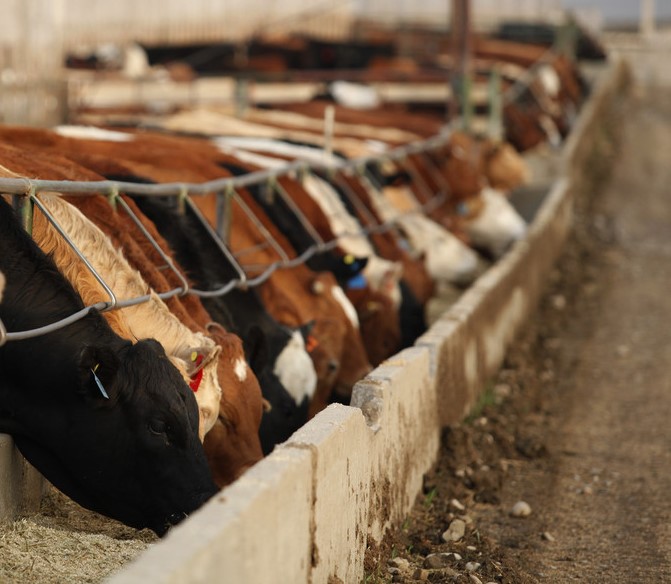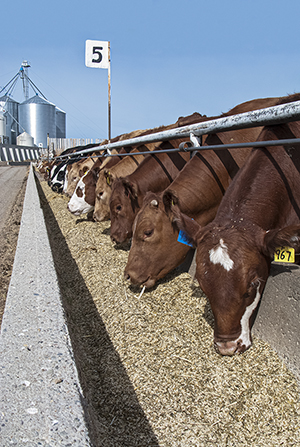M. bovis, Repeat Offender 🎙️
This article written by Dr. Reynold Bergen, BCRC Science Director, originally appeared in the September 2023 issue of Canadian Cattlemen magazine and is reprinted on BeefResearch.ca with permission of the publisher.
CLICK THE PLAY BUTTON TO LISTEN TO THIS ARTICLE:

“Police describe the suspect as being in his twenties with shaggy brown hair, wearing a black hoodie, white sneakers, blue jeans and a green backpack. He is known to associate with members of a criminal gang.”
If that was me, I’d be quick to cut my hair short, dye it gray, grow a distracting moustache and change my clothes. That’d throw the heat off for a while. The “known associates” part may be a bit harder to manage.
Mycoplasma bovis behaves similarly. Like all pathogens, M. bovis “wears” distinctive antigen proteins on its cell surface. When the animal’s immune system recognizes those antigens as potentially dangerous, it circulates the suspect’s description and recruits antibodies to apprehend it. But M. bovis is trickier than most microbes. It can switch which antigens it displays – it can change its clothes. This delays the immune system from recognizing it and allows M. bovis to continue its crime spree throughout the animal, potentially resulting in chronic pneumonia and arthritis.
The changeability of M. bovis has slowed the development of effective M. bovis vaccines. A research team led by Tony Ruzzini at the Western College of Veterinary Medicine is taking a different approach. They are trying to develop drugs to disrupt the M. bovis cell membrane, expose all its hidden antigens and allow the immune system to recognize all its possible disguises regardless of what it happens to be wearing on any given day. But these are early days of a long-term project.
In the meantime, Jeff Caswell at the Ontario Veterinary College and colleagues have studied whether M. bovis behaves differently when on its own or with its “known associates” (Effect of aerosolized bacterial lysate on development of naturally occurring respiratory disease in beef calves; DOI: 10.1111/jvim.16032).
What They Did
In two small pilot studies, beef calves were challenged with M. bovis alone, or with both M. bovis and a BRD virus (BHV-1; study 1) or BRD bacteria (Mannheimia haemolytica; DOI: 10.1016/j.vetmic.2023.109793). Both studies suggested that M. bovis didn’t cause significant problems on its own. But the additional inflammation caused by the other pathogen allowed M. bovis to gain a foothold and cause significant disease.
A follow-up feedlot study used 60 lightweight (490 lbs), high-risk auction mart calves. No antibiotics were given on arrival. Half were given a dose of burst-open E. coli and S. aureus cells (“lysate”). These bacteria do not cause BRD, but they do trigger inflammation, which is the body’s most rapid and generalized response to an injury or infection. They used E. coli and S. aureus instead of BRD pathogens because they didn’t know whether the calves had been vaccinated against BRD or not. They wanted the immune system to be responding similarly across all animals, and using a lysate of BRD microbes may have inadvertently provided a protective “booster” to any vaccinated calves and confused the results.
The lysate treatment used essentially caused the calves’ immune system to respond as though they were already dealing with an infection when they arrived at the feedlot. The other 30 control calves were given saline. Body weight, rectal temperature, nasal swabs and lung ultrasound scores were collected over the feeding period. Treatment rates were recorded, and post-mortem lung samples were tested for BRD bacteria and viruses.
What They Learned
The lysate and control calves had the same average body weight, rectal temperature and lung scores on day 0. Over the first month, the control group grew slowly while the lysate group lost weight and had higher rectal temperatures. Over the whole feeding period, growth rate, BRD initial and retreatment BRD rates and lung scores were the same between the two groups.
There were more M. bovis bacteria in nasal samples from the lysate group than from the control group. But most significantly, death losses due to M. bovis pneumonia were significantly higher (20%) in the lysate group than the control group (3%). Roughly half of the Mycoplasma mortalities also had arthritis. Most Mycoplasma deaths occurred in the second month after arrival.
So What Does This Mean…To You?

These studies suggest that Mycoplasma may not be a problem when it’s all by itself. But when it hangs around with the wrong crowd, it can cause tremendous damage. Inflammation caused by other respiratory pathogens can increase the risk of Mycoplasma pneumonia and arthritis. Other research from this team suggests that calves that have previously been sick with Mannheimia are also more likely to become ill with Mycoplasma later. Viruses and bacteria aren’t the only things that can cause inflammation – so can dust and other irritants.
After a dry fall and tough winter, this summer’s drought may produce some nutritionally-compromised calves that enter the feedlot. The dust and smoke likely won’t help their lungs, either. Now might be a really good time for feedlot operators to talk to their nutritionists and veterinarians about their procurement, receiving, health and nutritional protocols for the upcoming fall run.
Bottom line:
Until effective M. bovis vaccines are available and widely adopted, ensuring calves are fully vaccinated against the other known BRD viruses and bacteria before arriving at the feedlot is our best defense against Mycoplasma.
The Beef Cattle Research Council is funded by the Canadian Beef Cattle Check-Off. The BCRC partners with Agriculture and Agri-Food Canada, provincial beef industry groups and governments to advance research and technology transfer supporting the Canadian beef industry’s vision to be recognized as a preferred supplier of healthy, high-quality beef, cattle, and genetics.
Click here to subscribe to the BCRC Blog and receive email notifications when new content is posted.
The sharing or reprinting of BCRC Blog articles is typically welcome and encouraged, however this article requires permission of the original publisher.
We welcome your questions, comments and suggestions. Contact us directly or generate public discussion by posting your thoughts below.